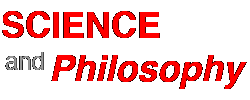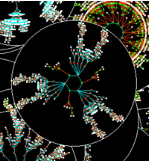Systems
in general
A system is a group of parts so linked together by interactions
that the group functions as a whole. The function or behavior of
the system is different from the function or behavior of the individual
parts.
As the scientific understanding of nature has increased and deepened, it has become evident that the world is more interconnected than we could have imagined…
An illustration of interconnections among systems comes from the science of ecology. By stressing the relationships among organisms and the reciprocal influence between those organisms and their environment, ecology has reinforced the idea that nature consists of systems within systems.
The fact that the word system is so frequently used indicates both the usefulness of the concept and the ubiquity of systems. Increasingly the world is viewed from a systems point of view. Besides biological and astronomical systems we recognize geological, economic, mechanical, legal, political, educational and logical systems, to name only a few.
Traditional science has been remarkably successful in finding out how things work by taking them apart and studying the pieces. The process is less successful when the entity examined is complex and the parts interdependent. Focusing on the parts tends to make the interactions disappear from our attention…
Systems can produce novelty. The properties of the whole system are more than the simple addition of the properties of the parts. Put electrical resistors, condensers, wires, transistors and a power source together in a certain relationship and a new property emerges - the ability to detect radio waves. This ability is not in any of the parts. It originates in the special relationship among the parts. Such new properties are usually impossible to predict when new systems form…
There is a general tendency for systems to combine to form more complex systems. Hierarchical organizations of nested systems are common in nature. As systems interact they influence and modify each other. New behaviors and new properties arise out of the interactions. The human body with its various subsystems is an example.
Some thinkers consider the tendency for systems to combine to be so important as to raise it to the level of a law of nature. The combined systems are often said to be higher level systems. The designation of higher and lower is not meant to be one of value. The distinction is made to identify those that are more complex from those that are simpler.
Self-organizing
systems
These are systems which spontaneously form from the association
of compatible parts. The forms and functions of the systems are
new and arise from the relationships among parts…
Self-organizing
systems exist on many levels, from self-organized atoms to gigantic
galactic systems to the universe itself. They can be divided into
groups according to their energy use. Some, like atoms, crystals
and the planetary system, require no input of energy from the outside
to maintain themselves. These systems are close to equilibrium.
Other self-organizing systems maintain themselves only through a
continuous exchange of energy and matter with their environment.
Because they are not only absorbing matter and energy but are also
shedding them, these systems have been called dissipative systems.
Living organisms are a prime example of such systems.
Characteristics
of self-organizing systems
1. Multiple components
Self-organizing systems are networks of many parts acting coherently.
Each part operates according to its own nature but within an environment
that is produced by its interactions with other parts in the system.
2.
Self-initiated interaction
It is important to emphasize that there is no agent or center inside
the system forming it… In the self-organized system of a free
economic market there is no central command center. The prices of
the goods are an outcome of the interaction of the participants.
3.
Self-configuration
As a self-organizing system constructs itself, the arrangement of
its constituent parts is determined by the internal relationships
of those parts. The cubic shape of salt crystals, for example, is
determined by the lattice formed by the alternating sodium and chloride
ions.
4.
Mutuality of influence - Interdependence
Just as system behavior is produced through the synergistic action
of the constituent parts, the behaviors of the parts are influenced
by their association within the system.
A consideration of flocking, schooling and herding behavior will
make this clearer. The spacing and speed of movement of each animal
produces the group behavior. However, the behavior of the group,
speeding up or turning to avoid predation for example, will change
the individual’s behavior.
It is this kind of mutuality of action which makes self-organized systems so difficult to study in the traditional reductionist way. Everything is in flux. The system is influenced by the parts and the parts may be changing because of the interactions within the system. There are many feedback arrangements.
5.
Communication (information exchange)
Since the action of a self-organizing system is a product of the
internal interactions of the parts, there must be some way for the
parts to influence each other for the system to function. Should
this information-exchange fail, the system would cease to operate.
How could blind birds form a flock? Or a market function with no
knowledge of prices? Feedback is also involved here.
6.
Self-maintenance - Adaptation to change
Within limits, a self-organizing system has the ability to preserve
its form and to reorganize itself in the face of disruption. The
flickering of the candle flame and the sweeping turns of a school
of fish are examples. The system is constantly reforming itself
as it responds to changes in its environment. Again, there are many
feedback arrangements that are involved.
A
special note on feedback and self-organizing systems
In all self-organizing and self-maintaining systems feedback is,
of necessity, an essential element. The notion is imbedded in the
concept of interconnectedness of system parts and mutuality of influence.
However, explanations using feedback mechanisms become extraordinarily
complex when dealing with self-organizing systems.
In a simple feedback system the change in output can be fed back to influence production and link the parts. But when more interconnected parts are added to a system it very quickly becomes impossible to disentangle the feedback circuits. In some cases the feedback may have diverse effects on different parts. For complex systems the concept of simple feedback is usually inadequate.
7.
Collective new properties produced
An aggregation of things that coalesce into a self-organizing system
becomes something more than a collection. As the parts establish
mutual relationships, the system as a whole acquires new collective
properties. When enough neurons come together and interconnections
are established among them, the property called consciousness comes
into being. The collective property is not within any of the parts.
It is a product of the interconnections.
8.
Divergent property of dissipative systems
The concept of dissipative systems originated in the work of llya
Prigogine for which he won the Nobel Prize in 1977. Dissipative
systems operate far from equilibrium. They take in and disperse
considerable quantities of matter and energy and exhibit instabilities
that make their courses impossible to predict. Although the actions
of such systems are bounded by the limits of physical laws they
have many ways of proceeding within those limits. Examples are the
touch down points and paths of tornados and the branching points
of plants.
Living organisms are obviously dissipative systems. From the same starting point in a constricting maze the second path of a subject animal is never the same as the first it traveled. Even genetically identical twins have different eye iris patterns and, in time as they interact with their environment, develop other differences. For dissipative systems there are divergent pathways. Many directions, all equally possible, are open to them and, as they move into a particular set of sequences, they create new possibilities that might not be available had they moved differently.
Biological evolution is one result of this divergent property. The path of species development must obey physical laws and environmental constraints but can never be predetermined. Another example of the feedback process is the fact that as species interact with the environment they also change the environment that helped to determine their development.
Summary
Using the above characteristics, self-organizing systems can be
described as those systems that have multiple components that initiate
their own interactions and configurations. Within such systems there
is an interdependence of parts and communication of some sort among
them. They are able to maintain themselves and adapt to changing
environments. Sometimes new properties are produced when they self-assemble
and those systems far from equilibrium may change in unexpected
ways.
Conclusion
The ability of systems to self-organize and spontaneously develop
new unpredictable behaviors or structures brings novelty into the
universe. Within the deterministic laws of physics, self-organizing
systems bring the unexpected, making the future unknown and unknowable.
Through these systems nature is creative.
The
second law of thermodynamics describes a universe running down to
changeless equilibrium. The development of self-organizing systems
shows a universe increasing its levels of complexity and organization,
albeit locally, at the expense of universal entropy increase.


